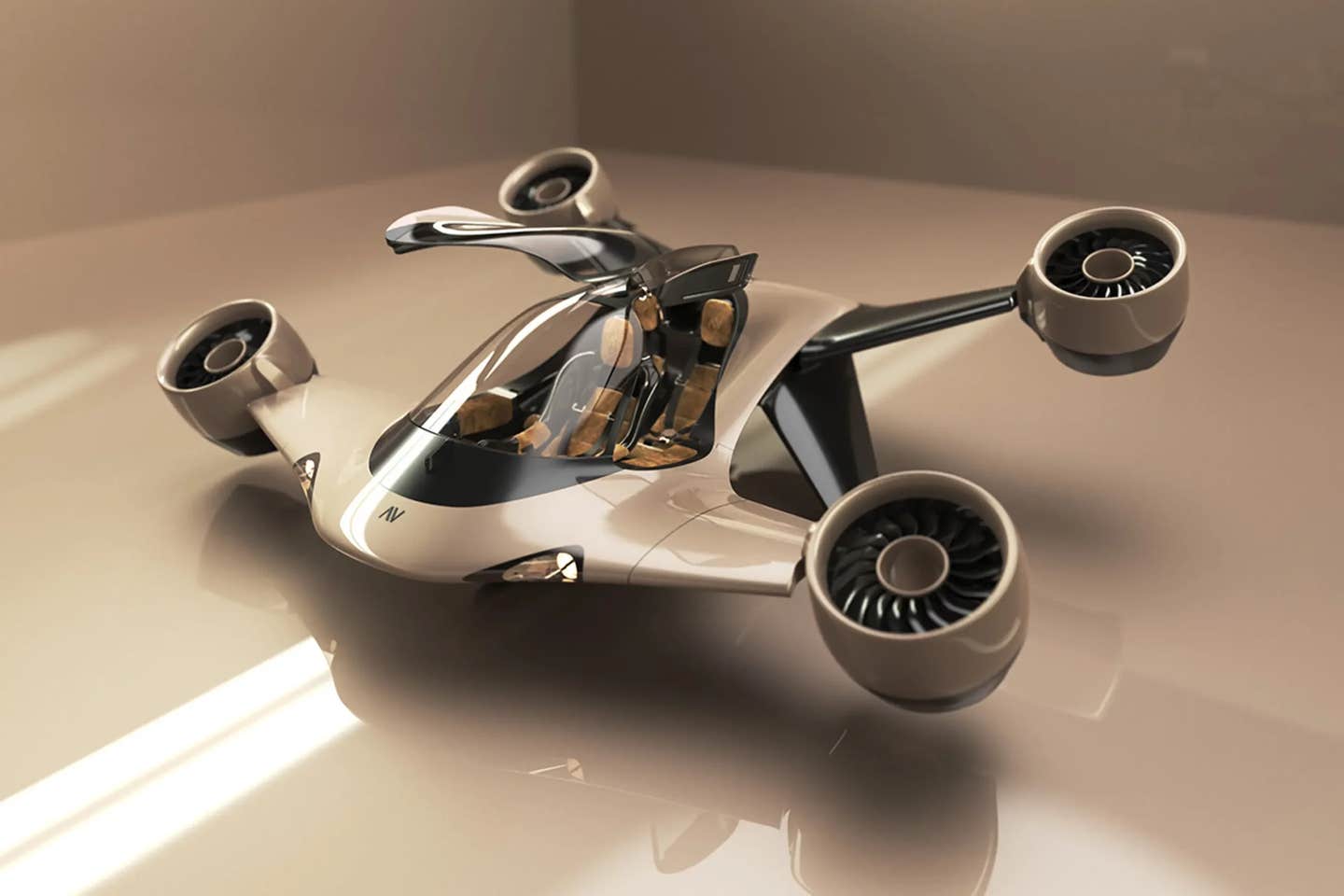AltoVolo’s 220 mph hybrid eVTOL aircraft redefines personal air travel
Sigma is a compact hybrid-electric aircraft offering quiet VTOL, 510-mile range, and private jet performance without a runway.

AltoVolo’s Sigma is a quiet, long-range hybrid jet redefining flight with vertical takeoff, private comfort, and driveway-sized dimensions. (CREDIT: AltoVolo)
A new kind of personal aircraft is challenging the future of flight. It’s sleek, quiet, compact, and unlike anything else in the sky. Born out of a bold idea, the Sigma by AltoVolo is aiming to reshape how we think about aviation—by combining the simplicity of vertical takeoff with the power and range of a jet.
While major companies focus on air taxis, AltoVolo is targeting something more personal. And the vehicle they’ve built just might make you believe in flying cars again.
A Jet That Lands on Your Driveway
At first glance, the Sigma looks more like a high-performance concept car than an aircraft. It’s sharp, compact, and surprisingly small—only about 4.8 meters wide, roughly the size of a two-car garage door. But behind the aerodynamic design lies an innovative system: a hybrid-electric propulsion setup that uses a patent-pending tilting electric jet mechanism.
This design gives the aircraft the unique ability to take off and land vertically like a helicopter, then cruise through the air at high speeds. Its energy system combines the burst strength of batteries with the energy density of liquid fuel, offering the best of both technologies. The result is a range of up to 510 miles and a cruise speed of 220 miles per hour.
Compared to other electric vertical takeoff and landing (eVTOL) vehicles, the Sigma's numbers are ambitious. For instance, Archer Aviation’s Midnight tops out at 150 mph and has a 100-mile range. Joby’s hydrogen demonstrator reached 523 miles last year, with a max speed of 200 mph. But these companies are building for the short-trip air taxi market. AltoVolo is looking beyond that—to a future where flying isn’t just about getting to a city. It’s about getting anywhere, anytime, on your own terms.
More Freedom, Less Noise
The Sigma offers a solution to one of the most common complaints about helicopters—noise. It’s more than 80% quieter than conventional rotorcraft, with a takeoff noise level around 65–70 decibels measured from 100 meters. That’s about as loud as a dishwasher, making it far more suited for use in residential neighborhoods, on private property, or even on a yacht.
Related Stories
This leap in sound reduction could open up new uses for vertical aircraft. Without the deafening roar of a turbine, landing pads could appear in places where traditional helicopters are banned or discouraged.
AltoVolo is betting big on that change. Its aircraft doesn’t need a runway or terminal. It can operate from driveways, rooftops, or open fields. There’s no schedule or boarding gate. The idea is simple: flight, when and where you want it.
Built for the Art of Living
From day one, AltoVolo’s vision has been clear. “The Sigma is a statement of intent, reimagining the way we live and travel on our planet,” says founder and CEO Will Wood. “We are building the fastest point-to-point transport solution and have already achieved significant breakthroughs to make this happen.”
The Sigma isn’t meant for crowded, short-haul loops between city centers. It’s designed for regional air mobility, giving people the power to fly over long distances without relying on public transport or urban infrastructure. Whether it's crossing mountains, skipping traffic, or just reaching a second home faster, the aircraft is built for a life of independence and choice.
With room for three passengers and a maximum takeoff weight of just under 1,000 kilograms, the Sigma feels more like a flying sports car than a small airplane. Its 1,608-horsepower powertrain is strong enough to maintain stable flight even after the failure of one jet. For added safety, it includes triple-redundant controls and a ballistic parachute that can deploy at only 50 feet of altitude.
From Prototype to Production
Though it may sound futuristic, AltoVolo is already making headway. The vehicle’s design has been validated by Dr. Richard E. Brown, a respected expert from Sophrodyne Aerospace.
Simulation testing has been supported by Ansys, known for providing software to Formula 1 racing teams. And autonomous flight controls come from Embention, the same Spanish firm that supplies certified controllers for Amazon Prime Air.
Scale prototype testing has already been completed. Now the company is preparing to build a full-scale demonstrator. A public waitlist for early customers will open in July. Those selected will be part of the first wave of Sigma owners—a group that, according to AltoVolo, won’t just be buying an aircraft. They’ll be choosing a new way to live.
The vehicle’s specs are striking: a top speed of 290 mph, a 10,000-foot ceiling, and a hover time of 15 minutes. On electric power alone, the Sigma can travel 260 miles. Its packed width—just over two meters—makes it small enough to fit in standard storage spaces. And with a payload of 270 kilograms, it can comfortably handle two passengers and luggage, or three light travelers.
The aircraft’s tilt-jet configuration allows for smoother vertical takeoffs, followed by level flight. Thrust vectoring adds to stability. Everything about the Sigma points to one goal: effortless, safe, personal flight.
Risk, Realism, and the Road Ahead
Of course, bold ideas often come with uncertainty. While AltoVolo has released renders and specs, questions remain about certification, manufacturing, and long-term reliability. Some observers have noted that there’s little public information about Will Wood’s background in aerospace. But with the right team, careful testing, and smart partnerships, these hurdles may be overcome.
The advanced air mobility space is crowded with players chasing different goals. Some are building air taxis for dense urban areas. Others want to replace helicopters for medical or industrial use. AltoVolo is carving its own lane—a lane made for individuals who value privacy, freedom, and speed.
The company has positioned the Sigma as a "vertical hybrid jet," but its approach goes beyond technology. It’s aiming to sell a lifestyle. No lines, no delays, no crowds. Just you, your destination, and the open sky.
Only time will tell how far this vision will fly. But if AltoVolo succeeds, it could mark a turning point in how we think about flight—not as a rare event, but as a part of daily life.
Taking Off into the Future
In a market filled with promise and prototypes, the Sigma stands out. It dares to dream bigger—not just by beating the numbers, but by changing what personal air travel could mean. It may be small in size, but its impact could be huge. From rooftops to runways to remote lakesides, flight might finally become something within reach.
AltoVolo’s journey is just beginning. And if their plan works, the sky won't be the limit—it'll be your highway.
AltoVolo Technical specifications:
- 3-seater hybrid electric VTOL aircraft
Performance:
- Hover Time: 15mins
- Payload: 270kg
- Cruise Speed: 220mph
- Top Speed: 290mph
- Hybrid Range: 510miles
- Electric Only Range: 260miles
- Estimated Noise Level, Take-off: 65-70dB(A) @ 100m
- Flight Ceiling: 10,000ft (3,050m)
Weight Dimensions:
- Max Take-off Weight: 980kg
- Length: 4,050mm
- Width: 4,800mm
- Packed Width: 2,280mm
- Total Height: 1,580mm
Safety:
- Control System Triple Redundancy
- Ballistic Parachute 50ft deployment
- Thrust Vectoring Stability
Note: The article above provided above by The Brighter Side of News.
Like these kind of feel good stories? Get The Brighter Side of News' newsletter.



